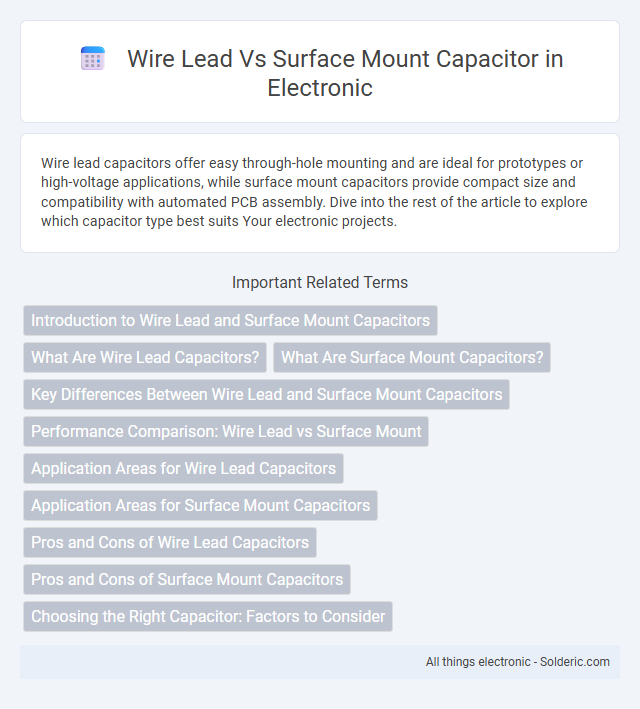Wire lead capacitors offer easy through-hole mounting and are ideal for prototypes or high-voltage applications, while surface mount capacitors provide compact size and compatibility with automated PCB assembly. Dive into the rest of the article to explore which capacitor type best suits Your electronic projects.
Comparison Table
| Feature | Wire Lead Capacitor | Surface Mount Capacitor |
|---|---|---|
| Mounting Type | Through-hole | Surface Mount Technology (SMT) |
| Size | Larger, bulkier | Compact, space-saving |
| Installation | Requires drilling and soldering | Placed and soldered on PCB surface |
| Mechanical Stability | Stronger due to leads | Less mechanical stress resistance |
| Electrical Performance | Low ESR and ESL, suitable for high power | Lower inductance, better high-frequency performance |
| Cost | Generally more expensive due to assembly | Cost-effective for mass production |
| Repairability | Easy to replace and test | Difficult to repair individually |
| Applications | Power supplies, audio circuits, high-reliability | Mobile devices, consumer electronics, compact assemblies |
Introduction to Wire Lead and Surface Mount Capacitors
Wire lead capacitors feature extended metal leads for through-hole mounting, offering robustness and ease of manual assembly in circuits requiring higher mechanical stability. Surface mount capacitors, designed for direct placement on PCB pads, enable compact, automated assembly and improved high-frequency performance in modern electronic devices. Your choice between these types depends on factors like assembly process, space constraints, and electrical requirements.
What Are Wire Lead Capacitors?
Wire lead capacitors feature two insulated wire leads extending from the capacitor body, allowing easy insertion into printed circuit boards (PCBs) or through-hole mounting. These capacitors are commonly used in applications requiring robust mechanical connections and easy replacement, such as power supplies and audio equipment. Their design supports higher voltage ratings and better heat dissipation compared to surface mount capacitors.
What Are Surface Mount Capacitors?
Surface mount capacitors (SMCs) are compact electronic components designed for mounting directly onto the surface of printed circuit boards (PCBs) without the need for wire leads. These capacitors offer enhanced performance in high-frequency applications due to reduced parasitic inductance and improved reliability in automated assembly processes. Widely used in modern electronics, SMCs come in various types such as ceramic, tantalum, and electrolytic, each optimized for specific capacitance, voltage ratings, and thermal stability.
Key Differences Between Wire Lead and Surface Mount Capacitors
Wire lead capacitors feature axial or radial leads designed for through-hole mounting, providing easier manual handling and stronger mechanical connections on printed circuit boards (PCBs). Surface mount capacitors, typically ceramic or tantalum, are mounted directly onto the PCB surface using solder pads, enabling higher component density and suitability for automated assembly processes. Wire lead capacitors generally offer higher capacitance values and voltage ratings, while surface mount capacitors excel in compact size and high-frequency performance.
Performance Comparison: Wire Lead vs Surface Mount
Wire lead capacitors typically offer higher voltage ratings and greater durability in high-stress environments, making them suitable for applications requiring robust mechanical support. Surface mount capacitors excel in high-frequency performance and automated assembly processes due to their smaller size and lower parasitic inductance. The choice depends on whether mechanical strength or compact, high-frequency efficiency is the priority in the electronic design.
Application Areas for Wire Lead Capacitors
Wire lead capacitors are widely used in applications requiring high reliability and durability, such as automotive electronics, power supplies, and industrial equipment. Their robust design allows them to handle higher voltage and withstand mechanical stress better than surface mount capacitors, making them ideal for environments with high vibration or temperature variations. You can find wire lead capacitors in circuits where easy replacement and long-term stability are crucial, especially in aerospace and military applications.
Application Areas for Surface Mount Capacitors
Surface mount capacitors are widely used in compact electronics such as smartphones, laptops, and wearable devices due to their small size and reliable performance. Their ability to be mounted directly onto circuit boards makes them ideal for high-density applications in automotive electronics, medical devices, and telecommunications equipment. You can benefit from surface mount capacitors when designing modern, space-efficient electronic systems requiring durability and precise electrical characteristics.
Pros and Cons of Wire Lead Capacitors
Wire lead capacitors offer excellent mechanical stability and ease of replacement due to their through-hole mounting design, making them ideal for applications subject to physical stress or requiring manual assembly. However, they tend to have larger size and slower response times compared to surface mount capacitors, which can limit their use in high-frequency or space-constrained circuits. Your choice of wire lead capacitors should balance durability and assembly convenience against size and performance requirements.
Pros and Cons of Surface Mount Capacitors
Surface mount capacitors offer benefits such as smaller size, better high-frequency performance, and automated placement for efficient mass production. They also reduce parasitic inductance and improve signal integrity, which is critical in high-speed electronics. However, surface mount capacitors can be more challenging to repair or replace compared to wire lead types, and their thermal dissipation may be less effective in certain applications.
Choosing the Right Capacitor: Factors to Consider
Choosing the right capacitor involves evaluating factors such as size, mounting method, and electrical performance. Wire lead capacitors offer easier manual assembly and are suitable for through-hole mounting, while surface mount capacitors provide compactness and superior high-frequency performance for automated PCB assembly. Your selection should consider space constraints, desired electrical characteristics, and manufacturing requirements to ensure optimal circuit reliability.
Wire lead vs surface mount capacitor Infographic

 solderic.com
solderic.com